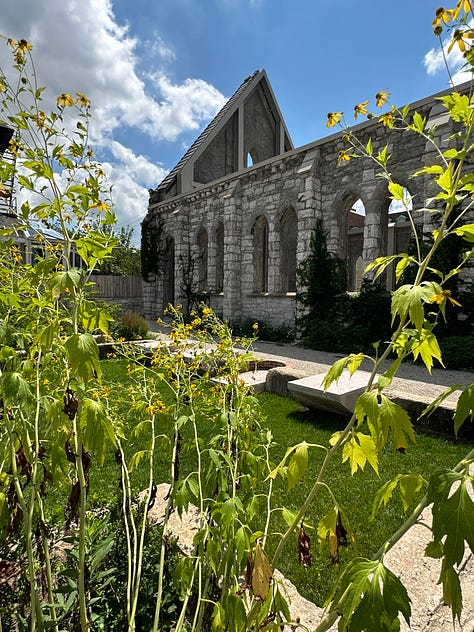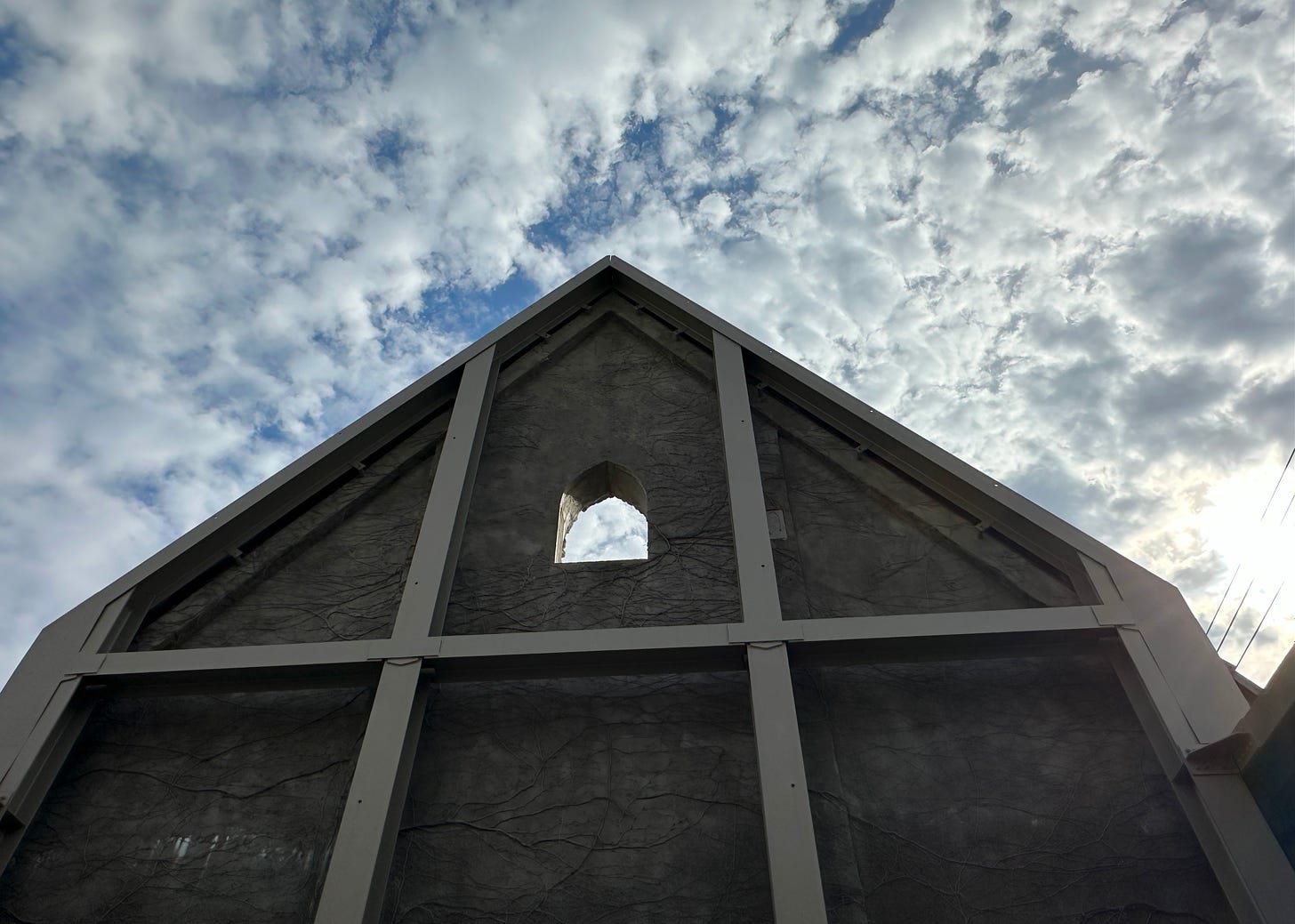Welcome to Unseen St. Louis, where I write about lesser-known bits about St. Louis’s history. Today, I wanted to share a story about historic buildings that keep going in new and inventive ways and how both can serve as a paradigm for historic preservation in the city.
Nestled on the western edge of the Grand Center Arts District of St. Louis, just a stone's throw from locations such as the iconic Fox Theater, the Contemporary Arts Museum, STL Public Radio, and the Pulitzer Arts Foundation, lies a site rich in its own history and architectural significance. While the site along North Spring Ave. may look like nothing more than the ruins of a church and an empty lot, it is, in fact, so much more.
This is the location of Spring Church and the former location of a townhome designed and inhabited by the famed architect Theodore Link.
Since 2020, both the church and the neighboring lot have experienced a profound transformation, weaving together the threads of their storied pasts with the vibrant tapestry of modern ambitions. Today, Spring Church, coupled with the garden next door, stands as a testament to architectural resilience and the value of historic preservation.
History of Spring Church
Located at 620 North Spring Ave in St. Louis, what we now know as Spring Church has a rich and varied history. Built in 1884, this Gothic Revival-style church was a small chapel made of limestone featuring 46-foot gables and unadorned plaster walls, and featured a stunning stained glass window that added to its architectural beauty.
Over the years, the church served as a spiritual haven for multiple congregations. Originally known as the Delmar Baptist Church, in 1893, the Church of the New Jerusalem acquired the building, and then in 1956, it became home to the Memorial Church of God in Christ. Under the leadership of Rev. William Turner, the final congregation moved to Spring Church in the 1950s from Mill Creek Valley after that community faced the wrecking ball. This congregation remained an active and integral part of the neighborhood until 2001.
A fire changed the church's fate
The story of Spring Church changed dramatically on the morning of March 27, 2001. A four-alarm fire, first noticed around 5:30 am by a security guard at the nearby Cochran VA Medical Center, engulfed the building.
By the time firefighters arrived, flames were shooting through the roof and windows. The four-alarm blaze destroyed the building, causing the fire department to declare the historic structure a total loss. Despite the smoldering ruins and a congregation in prayer across the street, Pastor Robert Chatman Williams expressed both loss and hope, noting, "It's only wood and stone. We can rebuild."

However, rebuilding the church proved unfeasible. The congregation had insured the church for only $40,000, an amount insufficient for the task of reconstruction. This event forced the last congregation to relocate, leaving the church in ruins and marking the end of an era for this once vibrant spiritual center.
In 2003, the nonprofit Grand Center, Inc. purchased the property, intending to turn it into an outdoor sculpture garden. However, the walls were deemed unsafe, and the plans never came to fruition, leaving the ruins to further deteriorate over the next 17 years.
Spring Church’s esteemed neighbor
Adjacent to Spring Church is a garden that was created from an empty lot where an important building once stood.
This lot, at 3746 Grandel Square, was once a townhouse complex designed c. 1905-06 by famed architect Theodore Link.
Link, a German immigrant who arrived in St. Louis in 1873, left an indelible mark on the city's architectural landscape. Born in Wimpfen, Germany, on March 17, 1850, he received his education in Heidelberg before training in architecture and engineering in London and Paris. His journey in the United States began in 1870, initially involving work in New York and Philadelphia and then as a civil engineer for the Texas Pacific Railroad.

After arriving in St. Louis, Link continued to build bridges and buildings for the Atlantic and Pacific Railroad Company. He emerged as a significant figure in developing the city's public parks, particularly Forest Park, which he began designing in 1874. Eventually, Link shifted to private practice, designing both homes and governmental buildings. His style, influenced by Henry Hobson Richardson's Romanesque Revival, was characterized by robust, block-like structures adorned with intricate details, rounded arches, and red-tile roofs.
Link designed these townhomes on Grandel Square during a period when he collaborated closely with Heidi Lange Roosevelt. The structure, as noted by architect and preservationist Gary Tetley, was a complex of three interconnected townhouses. Two of the buildings faced Spring Avenue, and the other fronted Delmar, part of Grandel Square. This was not just an architectural project for Link; it was also a personal one. He and his wife, Annie Fuller, resided in one of these townhouses, while the other two served as homes for his sons' families.



Theodore Link's architectural legacy is vast, ranging from residential buildings to grand civic structures. His best-known work, St. Louis Union Station, completed in 1894, is a masterpiece of Richardsonian Romanesque style. He also contributed significantly to the character of St. Louis through various projects, including the design of the Westmoreland Place and Portland Place gates, the Barr branch library, and the Second Presbyterian Church. His influence extended beyond Missouri, with notable projects like the Mississippi State Capitol and the Louisiana State University campus in Baton Rouge. His commitment to his work was profound; he passed away in 1923 in Baton Rouge while working on the LSU campus.


The fate of the townhomes
In 1926, Link’s widow sold the estate to Mark Eagleton, who transformed the building into offices for his law firm, Eagleton & Gunn Attorneys. This firm played a pivotal role in the early career of Mark's son, Thomas Eagleton, who emerged as a significant political figure and eventually became a Missouri Senator.
Just like with Spring Church, the Old Eagleton Building suffered a tragic outcome when on December 1, 1974. A fire broke out, causing severe damage, particularly to the upper floors. The fire's origin, suspiciously starting in a staircase on the second floor, marked the beginning of the end for this architectural piece. After the fire, the building could not be restored to its former glory and eventually faced demolition. Spring Church and the Link building today
The narrative of this stretch of North Spring Avenue took a hopeful turn with the involvement of the Pulitzer Arts Foundation. In May 2020, the Foundation purchased the 1,960-square-foot church and the neighboring empty lot that had been the site of the Link townhomes. The Pulitzer’s vision was to transform this space into a welcoming, open-air area for community members and artists.








Under the direction of Pulitzer’s executive director Cara Starke, extensive renovations began, focusing on stabilizing the church's framework while preserving its historical essence. Speaking to Gazelle Magazine, Starke said, "You could tell something happened here," referring to the church and the adjacent land. "And we want to give it that sense of history." Lead architect Kiku Obata of Kiku Obata & Company explained that it was important “to be able to walk into the church and see the sky.” Upgrades included reinforcing the historic masonry, adding accessible pathways, and installing new electric conduits and lighting, while the roofless church and the ivy adorning its walls were preserved.
Meanwhile, the lot where Link’s townhomes once stood is now a landscaped garden, revitalized with the efforts of Studio Land Arts. It incorporates bits of recycled and found items as well as original architectural elements from the buildings once located on this lot.
Today, Spring Church and the garden stand together as symbols of resilience and rebirth, a testament to the historical and architectural significance of the site.
(Many thanks to Gary Tetley for providing details about the Link townhomes, including historical images.)
Thanks as always for reading. If you enjoy Unseen St. Louis, please subscribe, and if you’re already a free subscriber, consider upgrading to a paid subscription to help support my work and keep it sustainable.
Sources:
Amanda Dahl, Spring Church Rises From the Ashes in St. Louis’ Grand Center Arts District, July 14, 2022.
Jane Henderson, From 'eyesore' to art venue: Shell of historic church to finally find new use, St. Louis Post-Dispatch, May 27, 2020.
Carolyn Hewes Toft, Theodore C. Link, FAIA (1850-1923), Landmarks Association of St. Louis, Inc.
Matt Hickman, In St. Louis, the ruins of a fire-ravaged church are revived by the Pulitzer Arts Foundation as a community art space, The Architect’s Newspaper, June 8, 2022.
Joni L. Kinsey, Theodore Carl Link (1850–1923), Missouri Encyclopedia, 1999.
Jaime Lees, Everyone’s Favorite St. Louis Church Is Getting a Makeover, Riverfront Times, May 28, 2020.
Trish Muyco-Tobin, From the Ruins, Spring Church Rises Again, Gazelle Magazine, June 29, 2022.
Kiku Obata, history of Spring Church, presentation at Spring Church, 4 November 2023.
Spring Church, Pulitzer Arts Foundation.
St. Louis Post-Dispatch, December 2, 1974 and March 28, 2001.
Gary Tetley, information about Link townhome and photos.






